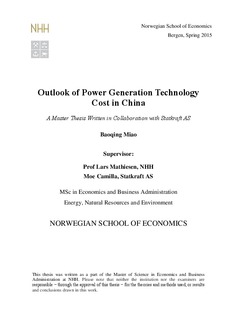Outlook of Power Generation Technology Cost in China : A Master Thesis Written in Collaboration with Statkraft AS
Master thesis
Permanent lenke
http://hdl.handle.net/11250/300594Utgivelsesdato
2015Metadata
Vis full innførselSamlinger
- Master Thesis [4372]
Sammendrag
This project is part of the broader project (hereinafter “Broad Project”) commissioned by the Technology Analysis unit in Innovation department of Statkraft AS to study the technology development path and Levelised Cost of Energy (LCOE) for both thermal and renewable power generations in emerging markets that Statkraft AS is present or has deep interest in, namely China, India, Brazil, Chile, Peru and Turkey. The project aims to project Total Overnight Cost (TOC) and LCOE of coal, natural gas, onshore wind and solar PV in these countries up to 2035, using Statkraft in-house excel model called “Cost Project Model”. By comparing these costs across technologies and countries, Statkraft will be able to devise its medium-term investment strategy based on competitiveness of each technology and country.
China is of particular interest to Statkraft even though it does not have significant investment in the Chinese market yet. The rationale is that China is believed to be the price setting country for most power generation technologies, particularly coal, solar PV, wind and potential nuclear through 2035. Given that China is already the top country in terms of newly installed capacity every year for these technologies, and that China has developed its own technologies and supply chain capabilities, it is not surprising to conclude that other markets, especially the emerging markets under this project will have their costs converging to that of China in the long term.
Therefore this particular project focuses on two aspects: the Chinese supply chain and export potential of Chinese technologies, and costs of power generation technologies up to 2035 in China. The Broad Project limits the scope to coal, CCGT, solar PV and onshore wind in China, Brazil, Chile, Peru, India and Turkey. This project will also touch upon nuclear as it is a very important part of Chinese energy mix in the long term, and is currently being promoted by the Chinese government as one of the two pillars of Chinese machinery export.
Chinese technologies, domestic installed capacity, current and historical export, production capacity, future production expansion were studies both quantitatively and qualitatively. It is concluded that except CCGT, China will be the price setting country for TOC for solar PV, wind, and coal and nuclear through 2035. Therefore in the actually modelling of other countries, their assumptions were adjusted slightly so that they costs will converge to that of China through 2035.
Both technical and financial data including CAPEX, OPEX, capacity factor, availability, fuel efficiency, construction time, and owner costs were collected for projects that were recently commissioned or planned in China. Assumptions such as WACC, economic lifetime and fuel
prices were collected from renowned sources and adjusted to the judgement of the author and Statkraft on current and forecasted market conditions.
The results of the simulation confirms the hypothesis that coal will remain to be the cheapest sources of electricity in China through 2035 without taking into account any carbon pricing, additional pollution controls or curtailment. Wind is already a relatively cheap source of electricity that will be comparable to nuclear by 2020 and approaching the cost of coal by 2035. Solar PV will see the sharpest cost decline in the next two decades.
